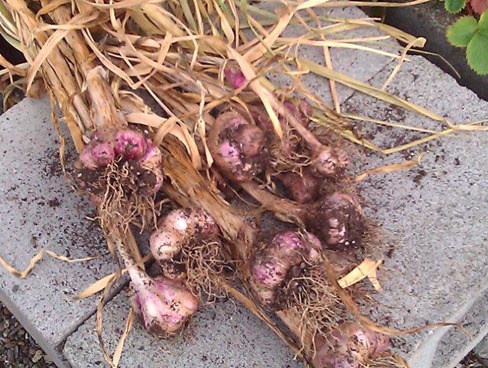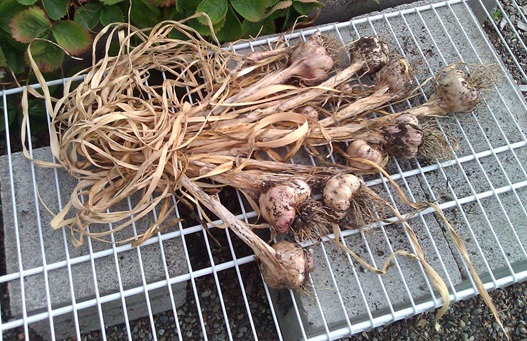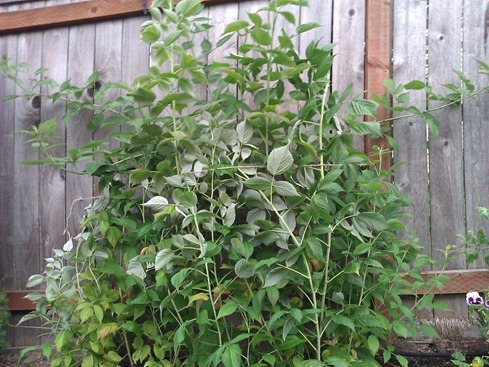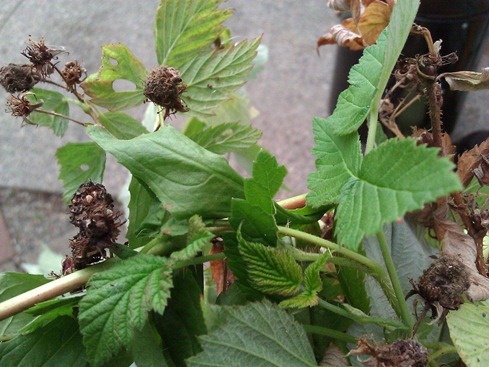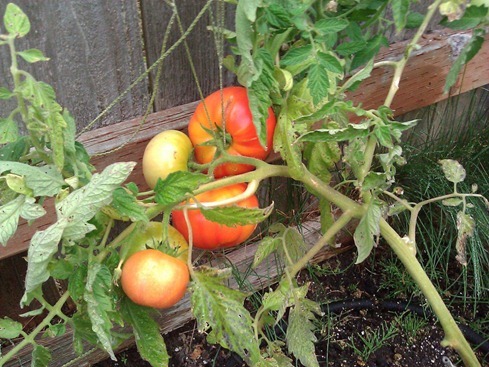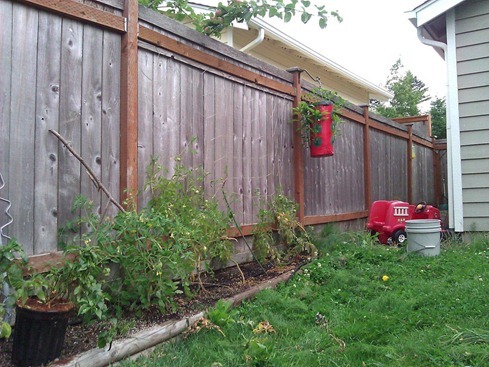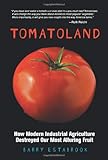using used tea bags to cover pot drainage holes
12.7 years ago Uncategorized
I saw this interesting suggestion I thought I should share. Instead of putting your tea bags in your garbage (or compost) place them in the bottom of your pots before planting. This helps keep the soil from draining out when you water and allows some nutrient to seep into your soil.
Via LifeHacker
All About the Tomato Hornworm: From How to ID Them to Best Tomato Hornworm
12.7 years ago organic, pests, tomato
Tomato hornworms are common garden pests. This post will show you how to identify them and the best tomato hornworm control methods.
About the Tomato Hornworm
The tomato hornworm becomes the five-spotted hawk moth. In its caterpillar form, it is incredibly disastrous to gardens and landscapes.
How to ID the Tomato Hornworm
The tomato hornworm is 4-5 inches long, once full size. Typically they are the largest caterpillars you will see in your garden. Green in color it has white V-shaped marks. Their color and markings help camouflage them in your garden. In fact, you may see their destruction before you see the actual caterpillar.
Tomato hornworms have enormous appetites, destroying entire leaves, stems and immature fruits.
Given their name, many incorrectly assume they only attack tomatoes. However, they also attack eggplants, peppers and potatoes. In a matter of days they can completely defoliate a plant.
If you don’t recognize their damage or spot one, you can ID these vicious pests by their black droppings, called frass, found at the base of plants or on leaves.
How to Control Tomato Hornworms
One of the simplest ways to control tomato hornworms is to pick them off whenever you see them. They are large and easy to grab when you spot them. Either squish them or spray them with organic pesticides.
Handpicking, however, can be time-consuming. Only best for very small gardens, handpicking will ultimately leave behind some of the caterpillars. And because even just one caterpillar will cause extensive damage, handpicking is often not the most effective way to end their infestation.
Beneficial Insects
There are insects that eat the tomato hornworm, such as the praying mantis. However, beneficial insects may not be in your garden. If you add these beneficial insects, they will end up leaving for other food sources once they can’t find pests in your garden anymore. Thus, relying on them as your sole form of pest control gives the pests another chance of infestation.
Applying BT
BT, or Bacillus Thuringiensis, can be used to treat a tomato hornworm infestation. However, it only works on small larvae, leaving the plant-destroying adults behind to continue their extensive damage.
Best Organic Tomato Hornworm Control
They make really effective organic pesticide products. They are easy to use and kill the tomato hornworms at all stages, ensuring you a healthy organic garden.
Available as sprays and powders, the most effective ones:
· Kill 45 different insect species
· Exterminate them at all stages, from eggs to adults
· Are ready-to-use
· Are OMRI Listed, which means they’ve been reviewed and approved for use in organic gardening.
Guest Author Byline This guest blog post is written by Michelle Anderson who specializes in insect control, including organic pesticides and insect killer.
How to cure garlic
12.7 years ago Uncategorized
Last year it was raining when I pulled my garlic and it almost seems like it hasn’t stopped running up to a couple of weeks ago. So unfortunately I was unable to properly let my garlic lay out in the sun for a few days to completely dry out. I did the best I could and braided the garlic and hung it up in my garage to keep the vampires away and to provide some awesome flavor to my cooking. Given my garage has some moisture and varying heat many of the cloves still were moist enough to start sprouting though I did have a good supply most of the winter.
Fortunately this year with out mild summer the garlic grew great and was able to pull them out a week ago and strangely enough there even was some sunshine to get them dry this year. I have taken a spare length of wire shelving and use it to move them in the garage at night and out to bask in the sunshine during the day.
Now they have a good tan off to braid them up and find a drier place to store them and should have garlic to eat for at least 6 months.
As for the sprouting garlic…will put that in the ground now for next year.
Trimming the raspberry bushes
12.7 years ago garden maintenance, raspberries
This weekend I decided to clean up the yard a bit and do some of my later in the season chores a little early. One of these on the list was trimming my new (second year) raspberry bushes. The first step was getting these bushes under control, if I had a larger space I probably would build a more stable construction for better airflow and make picking easier…but given my small space I simply took a couple nails and a couple of lengths of twine and loosely supported the stems to keep them from falling over into our lawn. Finish by tying the twine around the nails and task number one is done.
The production of raspberries goes in a two year cycle. The first year you get vegetative stalks (all green no flowers or berries) and the second year these previous vegetative stalks become flowering stalks and produce nice delicious berries. During this time more vegetative stalks develop and the process repeats itself. Once a flowering stalk completes delivering all of its berries it will turn brown and die off. Taking care of these was my first task. All this requires is finding the flowing stalks and cut them at their base, easy way to go is to cut anything brown and then pull them out (using gloves is advised)
This part was pretty easy since I only have a few flowering stalks the first year but you can see from the picture above I should get a decent crop of raspberries now the plant is becoming more established.
Now I simply let the plants do their thing and when the leaves fall off I will trim them to a height of about 5 feet, next spring given them a healthy scoop of alfalfa pellets and wait for the bounty of sweetness to come in next summer.
Go tomatoes go
12.7 years ago Pacific Northwest, tomato
I am a bit jealous seeing pictures across the country/world of everyone’s baskets of tomatoes, but I am getting close to my first few tomatoes on their modest vines starting to turn red…I see some salsa in my near future.
Tomatoland: How modern industrial agriculture destroyed our most alluring fruit review
12.7 years ago book, organic, product review, tomato
There is a very good reason why tomatoes are the most popular vegetable grown in the home garden, you can’t beat the taste of a home grown tomato. Tomatoland provides and exposé of specifically the Florida tomato industry showing many of the negative, though there are still a few positives explaining the history and the process of getting this previously alluring fruit to your local grocery store. After reading I can now add several other reasons to avoid purchasing those perfectly round and red commercial tomatoes at my local grocery store which I will explain in more details below.
Matter of Taste
As many of you may or not know below is what your delicious red tomato looks like when picked from the vine. By picking the tomatoes young this helps prevent fungal diseases prone to the humid Florida area where a good portion of our tomatoes from grocery stores and restaurants are grown. This also assists in the transportation of these tomatoes without damage to areas like where I live which is about far away from Florida as you can get. So how does these less appealing tomatoes look like the perfect ones we see in the stores? Once they reach their destination they are gassed with ethylene to give them their nice red appearance.
There have also been decades of breeding to produce a perfectly round, high yielding tomato, disease tolerant, and of proper size. Unfortunately during this process taste has not really been a consideration into this breading process. Along with taste tomatoes have lost much of the nutritional value they have had in the past. “According to analyses conducted by the U.S. Department of Agriculture, 100 grams of fresh tomato today has 30 percent less vitamin C, 30 percent less thiamin, 19 percent less niacin, and 62 percent less calcium. So you grandmother may have been correct telling you to eat your vegetables back in the day…sadly maybe this is no longer the case.
Human Factor
Most people are aware that insecticides and pesticides are used to grow most of our commercially produced produce. We have been told that end up on our fruits are so small that there is no risk to humans. This statement is definitely an easily arguable statement but in this book the author goes into great detail of the effects of these pesticides on the farm workers who were forced to go into fields too soon before application and in many cases pesticides actually being sprayed directly on the workers. As a result this led to many cases of reproductive issues with the farmers leading to many cases of abnormalities of children at birth as well as sickness and injuries, rashes during the immediate exposure.
The book also details the outright slavery existing in the Florida tomato fields as less than a decade ago. This is something that surprised me that I had not heard about this. There are also examples of modern day indentured servitude by offering an appealing wage but then extorting money from the workers for simple items such as water, “showers” (using a garden hose to rinse of pesticides, food, and premium rent at living quarters which normally would include sharing a small trailer with several other men.
Overall
Overall I thought Tomatoland was a great book and help reinforce my reasons for growing my own produce and supporting my local organic farmers. It also encouraged me to me aware of who’s hands my food my travel as I decide to make a purchase at my local grocery store. I would recommend this book to anyone who feels that paying a little extra for organic products is just too much to pay or anyone simply interested in how the tomato industry is run.


